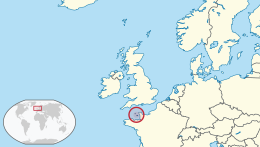
| Part of a series on |
| Jews and Judaism |
|---|
 Satellite photo of the Channel Islands in 2018 | |
 Location of the Channel Islands | |
| Geography | |
| Location | Western Europe |
| Coordinates | 49°26′N 2°19′W / 49.433°N 2.317°W |
| Adjacent to | English Channel |
| Total islands | 7 inhabited |
| Major islands | Jersey and Guernsey |
| Area | 198 km2 (76 sq mi) |
| Highest point | Les Platons |
| Administration | |
| Capital and largest settlement | Saint Peter Port, Guernsey |
| Area covered | 78 km2 (30 sq mi; 39.4%) |
| Capital and largest settlement | Saint Helier, Jersey |
| Area covered | 118 km2 (46 sq mi; 59.6%) |
| Demographics | |
| Demonym | Channel Islander |
| Population | 171,916[1][2] (2021) |
| Pop. density | 844.6/km2 (2187.5/sq mi) |
| Additional information | |
| Time zone | |
| • Summer (DST) | |
The history of the Jews in Guernsey dates back to well before the events of 1940–5. A London Jew named Abraham was described in 1277 as being from "La Gelnseye" (Guernsey). A converted Portuguese Jew, Edward Brampton, was appointed Governor of Guernsey in 1482.
Guernsey's Jewish population has historically been much smaller than that of neighboring Jersey, and there has never been a synagogue on the island.[3]
- ^ "World Population Prospects 2022". United Nations Department of Economic and Social Affairs, Population Division. Retrieved July 17, 2022.
- ^ "World Population Prospects 2022: Demographic indicators by region, subregion and country, annually for 1950-2100" (XSLX) ("Total Population, as of 1 July (thousands)"). United Nations Department of Economic and Social Affairs, Population Division. Retrieved July 17, 2022.
- ^ Shulman, David; Messik, Louise. "JCR-UK: The Channel Islands Jewish Community". JCR-UK. Retrieved 19 March 2015.
